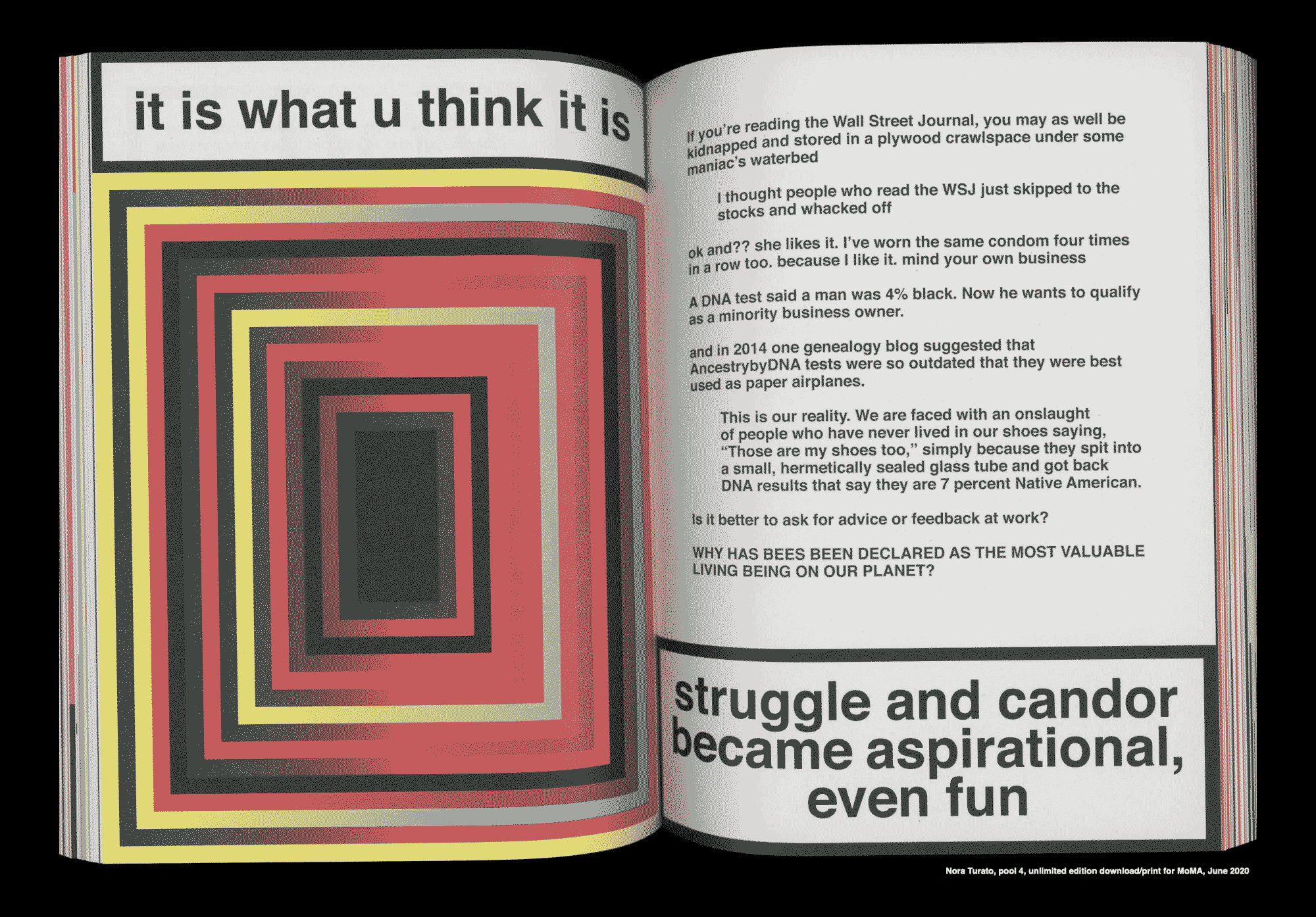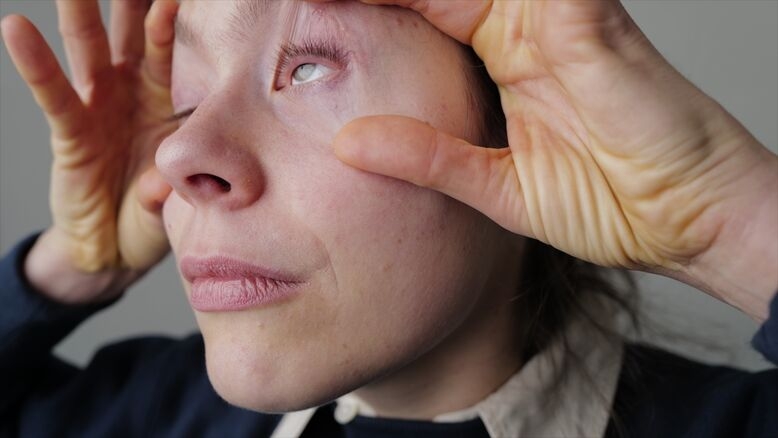pool7
Monday 7 July 2025
thoughts
Thoughts on the exhibition pool7 by Nora Turato.
word sick

I simply did not like pool7 by Nora Turato. Perhaps I did not understand it, perhaps it was not ‘for’ me or ‘my’ interests, however the shows key theme(s) – language, it’s relationship to the body, to technology, to graphic design, it’s reconstruction through sound, ‘found language’ and autofiction – suggested otherwise. As did the previous pools 4, 5 and 6.
The show featured scraps of text, writing, notes, printed on A4 sheets of paper arranged in a grid on the ICA walls. In a way, it seems pointless to recite these fragments here, in series, because the ‘impact’ of the artwork was to be felt in their overlapping, un-edited, non-linear arrangement. And yet, not to focus on the content of these messages would be to admit – perhaps, as pool7 implies – that contemporary culture has fully succeeded in hollowing out that term itself.

An install shot of pool7
So yes, the fragments, to cite Flash Art’s gloss:
...a flood of compulsive language confronting the lived tensions of late capitalist subjecthood: being a woman, an artist, a consumer, and a body. Anger, hope, hunger, humor, and despair pulse through voice memo–like rants on cultural inertia — “it’s the freeze in everything / in our bodies / in our cells / in our culture / in the air” — and poetic mantras: “HIDE / SEEK / SOOTHE.” A critical and self-reflexive thread runs throughout, on making art and surviving under capitalism: “fuck endurance art / I’ve endured enough,” she writes. “I need to make a living / and that means selling my work?” Technology, calendars, agendas — tools of bureaucratic optimization — appear as jarring mechanisms of control, disciplining unruly subjectivity into quantifiable systems: “ALL FUCKED BY THE EXCEL SHEET!”; “excel sheets rule the planet / did u know that?” 1
In previous ‘pools’ language was presented (often through a publication), in Turato’s words, as a kind of “annual report”, “a hard copy of language we exchanged, something that will gain significance as time passes.”2 Methodologically, this situates the artist as a kind of magpie, ‘plucking instinctively’ without the need for rationalisation or an overall curatorial schema. A kind of ‘automatic reading’, ‘readymade’ or ‘uncreative writing’. A picture is painted of the artist – as well as the ‘moment’, the ‘year’ – through the language that crosses her path. What is interesting or exciting about the entries in pool4, for example, is this double ambiguity – take the phrase: “A chronic Lyme diagnosis is a kind of belief system” – (1) in what context could this possibly have been uttered or typed? (2) what was it that drew the artist to catalogue and reproduce this text?
In a chapter of his book Uncreative Writing exploring the ‘poetics of hyperrealism’, Kenneth Goldsmith discusses the ‘found poetry’ of Ara Shirinyan, which – similar to Turato – collects and reproduces text from within an increasingly digitised culture.3 He argues that the “careful selection and juxtaposition of phrases [in such work, provides an] example of how a writer might go about carving a technology-fueled postidentity writing practice, one that makes the reader wonder whether the author’s identity actually had anything to do with the person who wrote it.”4
The effect of this process is a kind of distributed identity (a ‘postidentity’) within the work itself, one which might better reflect the ‘real’ (‘hyperreal’, surreal(?)) nature of a world – or at least the ‘platforms’ which make up a world – in which we have unprecedented access to the words of others. In this way, moral (aesthetic?) judgement is passed smoothly to the reader, and the role of the artist is largely to make this hand-off as fluid – as invisible – as possible.

This is not to say, however, that there are no artistic (design?) interventions in Turato’s pools – Turato has said that “Graphic design gave me the freedom to be an artist.” In pool4 statements are typeset in spreads reminicent of Marshall McLuhan’s The Medium is the Massage, Jenny Holzer’s Truisms or Barbara Kruger’s ‘statements’, interlaced with a particular kind of ‘postinternet’ irony. Some are earmarked as ‘warnings’, set in the style of a cigarette-box notice; others are laid over brightly-coloured concentric windows, like the ‘abstract browsing’ of Rafaël Rozendaal or an op art maze. In later examples, where text has moved to the walls of a gallery space or motion-graphics, these arrangements speak to the conceptual pop-art of Ed Ruscha or (in a perhaps ungenerous comparison) Douglas Coupland.5

A scan from pool4
All this, however, is reversed in pool7. The exhibition guide at the ICA tells us that in pool7, the fragments of text are Turato’s “most personal to date, [... incorporating] the artist’s own writing to a new degree.” 6 Whereas previously text was ‘found’ (written anonymously) here it is ‘authored’ or “disclosed” (albeit somewhat ambiguously or ambivalently). Perhaps to compensate for this, Turato’s graphic reworkings have therefore taken on a more minimal character, each phrase typeset in an Arial, or Helvetica variant, sized and shaped to suggest the notes app on your phone. This is interesting insofar as it gives us an insight into the artists writing or collecting process, and signals a desire to represent this language as something ‘unmediated’ – ‘closer’ to the experience of the artist herself. However it also revokes Turato’s status as a conduit (elsewhere she has been described as a ‘medium’) of the hyperreal, of ‘postidentity’ writing and life; arguably what made previous pools so dynamic and worthwhile.
This focus on the ‘self’ – typically framed through the concept of ‘the body’ – has been explored in previous pools, often through performance. In exhibiting pool5, for example, Turato memorized and recited various pages, or excerpts, from the book for spoken-word performances (for example, in MoMA in 2022). Beyond interpretations (by Flash Art and others) of the texts selected by Turato, which might, for example, feature ‘internet slang’, this is the clearest way – to my mind – that the artist had previously explicitly related her work to the ‘lived tensions of late capitalist subjecthood’, or technological, ‘bureaucratic optimization’. In pool5 the performances were a direct attempt to act as a ‘filter’, as she has said, to “match my body with all this information”, and express her “feeling [that] we live in times where our biology is pretty much out of sync with technology surrounding us.”7
In pool7 Turato doubles-down on these concerns and perfomative techniques through a new series of short films and a dedicated 15-minute audio piece. These feature the artist contorting herself, both physiologically and sonically, repeating phrases from the works, exploring the limits of a body (biological, linguistic) in a state of cultural and material malfunction – guttural expressions, groans, wretching repetitions, hesitations.

But is this ‘a’ body in general (a representation), or ‘her’ body? The artists body, in particular? The introduction of a more direct authorial voice again complicates and undermines this image – so important to previous pools – of Turato as a kind of ‘virtuosic’ mass-cultural mediator. Mirroring the world pool7 appears keen to critique, what was once polyvocal and endemic (collective) becomes univocal and pathologised (individualised). And so we are left then with the question, what is it that Turato wants to say, as Turato? And what is it that’s stopping her, that’s forcing her to convulse?
The discourse around pool7 – and her previous work – would have us believe this disjuncture (the gap between the body and language, truth and post-truth) is a consequence of techno-capitalist acceleration, and that forms of resistance, critique and observation might be found in performative or ‘exhaustive’ forms of vulnerability and disclosure. However, in this stripped back form – supposedly free of mediating frames – it seems that all Turato can do is get in her own way, giving rise to a show that is doubly ‘self-centred’. Are we supposed to believe that what she truly wants to communicate – between the groans and stutters – are pseudo-profound reflections on excel sheets, endurance art and capitalist exploitation:
I need to make a living
and that means selling my work?
Maybe not. As Turato writes in one of pool7’s statements: “been trying to pull myself out of my own ass”. Phrases like this demonstrate an awareness of the risks of pool7’s reversed approach, and in so doing, seek to anticipate or integrate critiques that might be made of it. After all, Turato is making designs, and in press releases and reviews she is consistently described as a ‘trickster’, a ‘charlatan’ and a ‘snake oil’ merchant.8
So, is there any sense in which we can read pool7 at face value? In the exhibition guide we read that with this exhibition Turato asks: “if the language we use to express our shared socio-cultural reality seems both unreliable and unmoored from the body, are those two things connected, and if so, how do we get back to stable ground?”
Was there ever a stable ground in the first place? To what arrangement are we supposed to return? In his book Monolingualism of the Other Derrida writes on the way in which ones own language, ones identity, is always constructed through the words and actions of others: “I have but one language—yet that language is not mine”; the desire of returning to a ‘lost’ language of ‘origin’ (a kind-of postcolonial demand, to master or reject the language of the colonizer).9
Are these the stakes of Turato’s work? The technofeudal colonisation of the body and the mind? The mission-creep of text-speak and memetic imagery into every aspect of life? It seems by removing the traces of everyone but herself the artist forecloses this reading – but perhaps this is yet another disavowal.
What pool7 reveals is not so much the gap between the body and language, or technology and biology, but the limits of disclosure itself. In stripping away the polyvocal textures of previous pools, in attempting to speak more directly, Turato paradoxically says less. The groans, stutters, and convulsions that punctuate the exhibition don't dramatize our collective predicament so much as demonstrate what happens when the medium becomes too self-conscious of its own mediation. pool7 is, in this sense, a dead-end. Where earlier pools gave us language as contagion – viral, spreading, anonymous – pool7 presents language as a symptom, turned inward and pathologized, without context or insight. One leaves as one arrives: word sick.
Footnotes
-
Nora Turato “pool7” ICA – Institute of Contemporary Arts / London by Sonja Teszler ↩
-
Pools of Performance: Nora Turato on the Found and Spoken Word, Ana Janevski, Nora Turato ↩
-
For a specific example of Shirinyan’s work discussed by Goldsmith, see Your Country Is Great (2008) ↩
-
Uncreative Writing (2011), Kenneth Goldsmith, p.90 ↩
-
In pool6 a custom typeface was even commissioned with Sam de Groot and Kia Tasbihgou. ↩
-
Pools of Performance: Nora Turato on the Found and Spoken Word, Ana Janevski, Nora Turato ↩